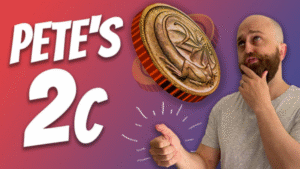
AE 1357
How to Pronounce -ED Endings in Australian English
Hey there! Get ready to boost your English skills with free ESL lessons. In these special episodes, we dive into all sorts of topics to help you speak like a local. We’ll break down tricky English grammar, teach you essential Australian slang, and even guide you through Australian pronunciation. It’s your chance to learn practical English that you can use every day. Tune in and start mastering Aussie English today!
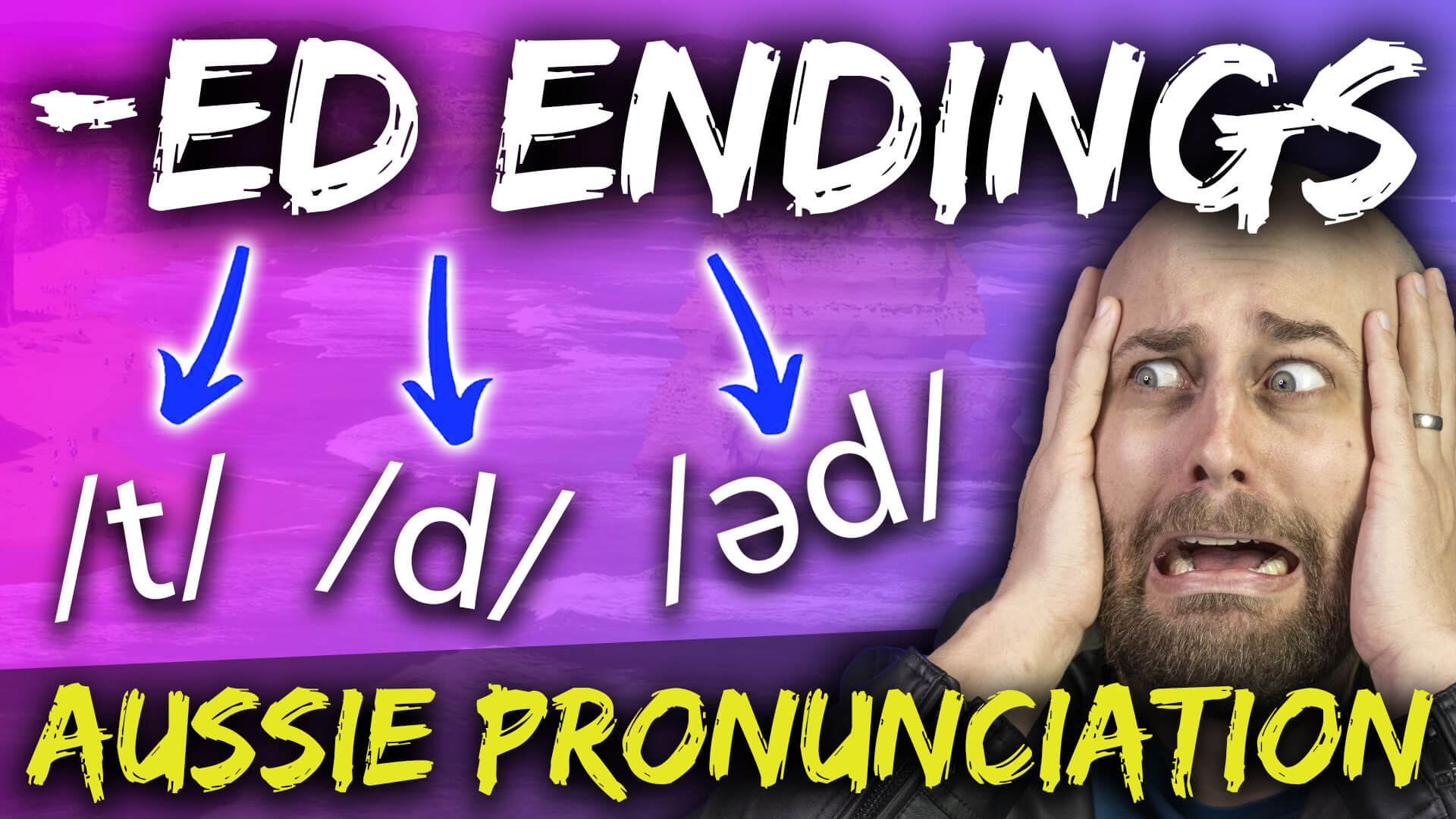
In today's episode...
G’day, you mob!
Ready to sound like a true blue Aussie legend? This ripper bonus episode of the Aussie English Podcast is your ultimate guide to nailing those tricky “-Ed” verb endings. Pete’s gonna walk you through 150 common words, helping your brain and mouth get used to how we speak Down Under. We’re talking unvoiced /T/ endings, voiced /D/ endings, and those classic /əd/ sounds – all designed to boost your confidence when you’re having a yarn in English. Plus, there’s a free PDF worksheet with all the words and their IPA transcriptions to help you practice along. So, if you’re keen to give your Aussie accent a fair dinkum boost, chuck on this episode and let’s get stuck in!
Listen now and get your Aussie pronunciation sorted!
** Want to wear the kookaburra shirt? **
Get yours here at https://aussieenglish.com.au/shirt
Improve your listening skills today – listen, play, & pause this episode – and start speaking like a native English speaker!
Listen to today's episode!
This is the FREE podcast player. You can fast-forward and rewind easily as well as slow down or speed up the audio to suit your level.
If you’d like to use the Premium Podcast Player as well as get the downloadable transcripts, audio files, and videos for episodes, you can get instant access by joining the Premium Podcast membership here.
Listen and Read!
Get started with our free, limited-run premium podcast player! This player allows you to effortlessly fast-forward and rewind, or adjust the playback speed to suit your listening level.
Want even more? Upgrade to our Premium Podcast membership to unlock the complete Premium Podcast Player, plus downloadable transcripts, audio files, and videos for every episode. Get instant access here.
Transcript of AE 1357 - How to Pronounce -ED Endings in Australian English
G'day you mob, and welcome to Aussie English! I am your host, Pete. And my objective here is to teach you guys the English spoken Down Under. So whether you want to sound like a fair dinkum Aussie or you just want to understand what the flippin' hell we're on about when we're having a yarn, you've come to the right place. So sit back, grab a cuppa and enjoy Aussie English. Let's go!
G'day you mob. How's it going? Welcome to this episode of Aussie English, the number one place for anyone and everyone wanting to learn Australian English. So today's episode is going to cover a very common issue that my students, my private students typically have, and I'm sure many other students out there learning English also have, and that is -Ed endings. How the hell do we pronounce these for regular verbs in the past tense.
Before we get into that, though, today's episode is brought to you by the Australian Pronunciation Course, my Australian Pronunciation course, designed to teach you how to speak like an Aussie, but I will get more into that later.
Don't forget to download today's free PDF worksheet so that you can follow along and practice everything that we go over. In this worksheet, you'll see all the words phrases. You'll see the IPA, the International Phonetic Alphabet, those symbols for different words as well, which will really help when trying to nail these different types of -Ed endings.
So yes, I've actually been working on -Ed endings quite a lot recently. That was the whole reason for putting this episode together with my private students. I've had about four of them typically who speak languages like Portuguese, Spanish or French. You know these romance languages, having trouble with these ed endings, but I'm sure it's not just unique to them. And so it prompted me to want to put together a, an episode like this, where I can teach you how these are pronounced.
And I will also be putting together a Members Only episode for premium podcast members, where we go over loads of exercises to hopefully help you learn to do this once and for all. So let's get into it.
There are three different types of Ed endings in English. You are going to have /t/, as in "talked". You're going to have /d/ as in "played", and you're going to have /əd/ or /ɪd/ as in "wanted". Okay. I would say it with the schwa sound /əd/, /ˈwɒntəd/ /ˈwɒntəd/.
So let's go through these one by one. So the first sound, the Unvoiced /t/ sound, we pronounce this -Ed ending as /t/. When the last sound of a verb is voiceless, it is unvoiced. There is no vibrating in the vocal cords in your throat. Okay, let's go through some examples.
"Talk" becomes /toːkt/. So it's got that voiceless K sound at the end of "talk", /k/ /k/ The voice version would be a G, /g/ /g/ /g/ where you're vibrating your vocal cords.
/Talk/ becomes /toːkt/.
/Laugh/ becomes /læft/. So that's the voiceless F, /læf/ /læf/ /læf/ /læft/.
/Pick/, another K sound. /Pick/ becomes /pɪkt/, and /wash/ becomes /wɔʃt/.
So, voiceless consonant sound at the end of a verb leads to the voiceless /t/ -Ed ending. So, one more time, repeat after me.
Talked - /toːkt/
Picked - /pɪkt/
Laughed - /læft/
Washed - /wɔʃt/
Feel how short and sharp that /t/ sound is.
Talked - /toːkt/
Picked - /pɪkt/
Laughed - /læft/
Washed - /wɔʃt/
So, if the verb ends with a voiceless consonant like /p/, /k/, /s/, /ʃ/, or /ʧ/, you're going to use /t/ at the end of that word ending in -Ed.
Let's go through a few short example sentences where we will use these within the sentence, okay. These different ed ending words with /t/ at the end. So, listen and repeat after me.
She laughed at the movie.
He helped me with my bag.
They watched the sunset.
I kissed her on the cheek.
Good job. Now I am kind of emphasising that T ending a little bit, just so that you can really hear it, and hopefully that helps you as you go through these exercises. I will do that in each case.
Okay. Part two. Now we're going to go through the /d/ sound. So this is the equivalent of /t/ but it's voiced, okay.
So, we pronounce the -Ed ending as /d/ when the last sound in the word or the verb here is voiced, that means your vocal cords are buzzing like /er/ or /z/ or any anything like that.
It can be a vowel sound or it can be a voiced consonant sound. Let's go through some examples.
So, the word "play" /play/, you've got this vowel at the end of /play/.
/Play/ becomes played /pleɪd/.
"Clean", /clean/, you've got this N sound at the end. /Clean/ becomes cleaned /kliːnd/.
"Call" /call/ becomes called /kɔːld/.
And "hug". /Hug/ becomes /hugged/, /hʌgd/.
Okay, so listen and repeat after me.
Played - /pleɪd/
Cleaned - /kliːnd/
Cold - /kɔːld/
Hugged - /hʌgd/
So, if your verb ends in a vowel sound or a voiced consonant sound like /l/, /n/, /g/, /v/, /m/, then you use the /d/ -Ed ending.
So let's practice some short sentences with the -Ed ending that is /d/. So, listen and repeat after me.
We played cards all night.
He cleaned the kitchen.
She hugged her brother goodbye.
I called them this morning.
Good job! Are you struggling to sound more natural when speaking English. Do Aussies ask you to repeat yourself? Or worse, just nod and smile?
If either of these things are the case, it's time to change that with the Aussie English Pronunciation course. Your step by step guide to mastering Australian English sounds and connected speech.
So inside the course it is split up into three different sections. The very first section teaches you how to use the International Phonetic Alphabet, the IPA, to level up your pronunciation on your own without the help of other people.
The second section goes through all of the vowel and consonant sounds in the Australian English general accent. They have detailed video tutorials and exercise videos and audio files for you to work on, so that you can easily and quickly master the pronunciation of all the sounds in Australian English.
And then the third section has 25 advanced lessons teaching you things like connected speech, the Australian R sound, when and why certain sounds disappear or change. And here's the best part.
Right now, you can get it for $100 off when you join with the link AussieEnglish.com.au/apc100. That's right, 100 bucks off!
So if you are ready to start sounding more Aussie when you speak English and start turning heads, go and check out the Australian pronunciation course at AussieEnglish.com.au/apc and let's get you speaking like a true blue Aussie legend now.
And finally, the third -Ed ending sound /ɪd/ or /əd/. It's quite often written as ID when people talk about it, but to be honest, in Australian English I would pronounce this as /əd/. It would be weird to hear someone say wantId or needId. You would hear typically the schwa, /ˈwɒntəd/ /ˈniːdəd/.
Okay, so we pronounce the -Ed ending as /əd/ with an extra syllable in there, that schwa syllable, before the /d/ sound. When the verb already ends with a /t/ or /d/ sound. So these are the sounds from the other -Ed endings.
If a verb already ends with those sounds, we have to obviously add in some kind of vowel sound, to then get to the second /d/ at the end, if that makes sense.
So, like /want/, in order to say an -Ed ending, again at the at the end. After that, you need a bit of space between the consonants with a vowel between them, right? /ˈwɒntəd/. Same with /need/ /ˈniːdəd/. You have to put in a vowel sound of some kind.
Okay, so let's go through some examples.
Want becomes /ˈwɒntəd/.
Decide becomes /dɪˈsaɪdəd/.
Start becomes /ˈstɑːtəd/.
And need becomes /ˈniːdəd/.
Now, one thing worth mentioning here is that if you have a vowel, sound either side of the T or D at the end of the verb, it may turn into a T or D flap.
So instead of 'deciDED', you may hear /dɪˈsaɪdəd/. Instead of 'starTED', you might hear /ˈstɑːtəd/. And the same with 'neeDED', you might hear /ˈniːdəd/.
Decided - /dɪˈsaɪdəd/
Started - /ˈstɑːtəd/
Needed - /ˈniːdəd/
That happens when you have T or D at the start of a syllable that is unstressed, and there are vowel sounds either side of it, okay. It's the easiest way for us to quickly say that T or D sound, with the T or D flap.
Alright, so repeat after me. Let's go through those words one more time.
Wanted - /ˈwɒntəd/
Decided - /dɪˈsaɪdəd/
Started - /ˈstɑːtəd/
Needed - /ˈniːdəd/
Good job. So when do we use it? When the base verb already ends with a /t/ or /d/ sound, we always go with /əd/.
So let's practice some short sentences with words ending in the /əd/ -Ed ending. Repeat after me.
She wanted to go home.
He needed some rest.
They decided to leave early.
I waited for the bus.
Good job. So those are the three different types of -Ed endings. It's that simple.
Let's sum it up.
We have /t/ as an -Ed ending after voiceless consonants like laughed, picked, washed.
We have /d/ after vowels, or voiced consonants like played, called, cleaned.
And we have /əd/ when the word already ends with a /t/ or /d/ sound like wanted needed, decided.
So, one last test for you guys. We've got a combination of these different words in a sentence here, or a couple of sentences or a paragraph. All right. So try saying this mini paragraph out loud after me. I'm going to say it two times. Okay I'll do one a little more slowly. Sentence by sentence. And then I'll do it more quickly. Okay. So listen and repeat after me.
Yesterday I walked to the park and played some music. I needed fresh air because I'd worked all morning and wanted a break.
All right, let's do it one more time. And now I will speed it up at a natural speed and with natural flow. Okay.
Yesterday I walked to the park and played some music. I needed fresh air because I'd worked all morning and wanted a break.
Well done guys, well done. I hope this episode helped. Don't forget to grab today's free worksheet. It'll have the different words the IPA. It'll have the sentences and everything that we've gone through so that you can follow along. As you listen to this episode, you can take notes, you can print it out, all that sort of stuff.
I also want to mention that there will be a Members Only episode for premium podcast members that will be full of exercises so that they can listen to those episodes and just do these exercises on repeat so that hopefully you learn to pronounce these different -Ed endings naturally.
So I'll probably include, I haven't done it yet, but I'll probably include 50 or more of these different types of -Ed endings. So for each one. So maybe 150 words and maybe sentences as well, we'll see what I end up doing.
If you want access to that, you can grab it when you sign up to become a Premium Podcast member at AussieEnglish.com.au/podcast.
And lastly, if you want to develop your Aussie accent and speak with confidence, be sure to check out my Australian Pronunciation course at AussieEnglish.com.au/apc100 the link will be in the description. Thanks again for joining me, mate. I hope you have a ripper of a week and I'll chat to you next time. Tooroo!
Get more out of every episode!

Premium Podcast members get access to...
- All 900+ podcast episodes including member-only episodes
- Member-only episode video lessons
- Downloadable transcript PDFs & audio files for every episode

Recent Episodes:


AE 1374 – 15 Expressions For Being Sick

AE 1373 – 25 Things That Only Happen in Australia | Australian Culture Shock

AE 1372 – 18 Weird Things That Shock Tourists in Japan | Japanese Culture Shock
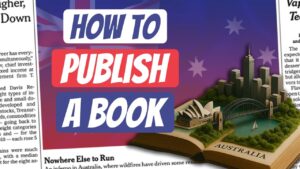
AE 1371 – The Goss: How Dad Self-Published a Book in Australia

AE 1370 – Learn English with a Short Story: Outback Breakdown
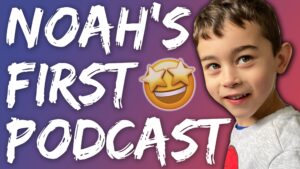
AE 1369 – Interview: A Silly Conversation With My Son Noah Smissen
AE 1368 – The Goss: What Are Some Australian Norms?

AE 1367 – Top 10 Aussie Movies

Share

Join my 5-Day FREE English Course!
Complete this 5-day course and learn how to study effectively with podcasts in order to level up your English quickly whilst having fun!
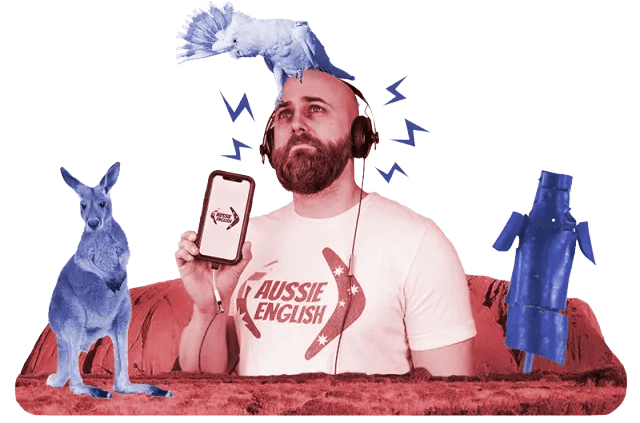
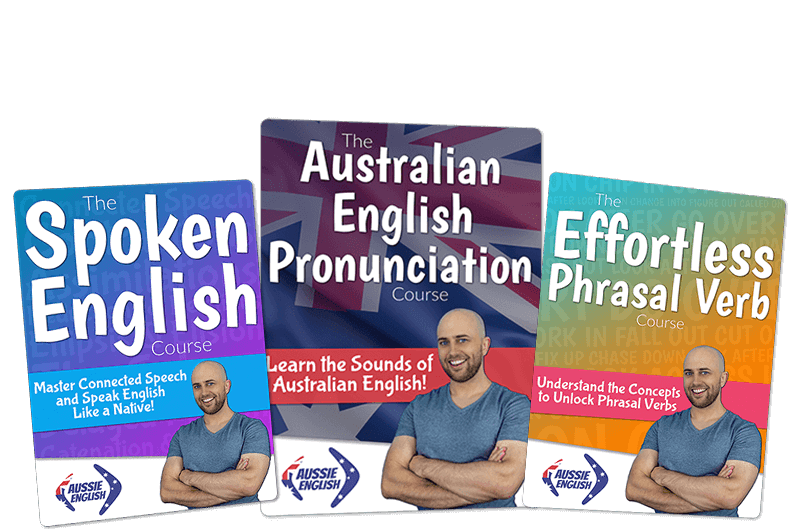
Want to improve a specific area of your English quickly and enjoyably?
Check out my series of Aussie English Courses.
English pronunciation, use of phrasal verbs, spoken English, and listening skills!
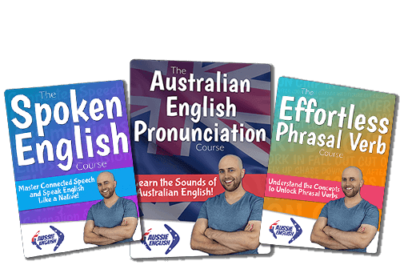
Want to improve a specific area of your English quickly and enjoyably?
Check out my series of Aussie English Courses.
English pronunciation, use of phrasal verbs, spoken English, and listening skills!
Leave a comment below & practice your English!







Responses